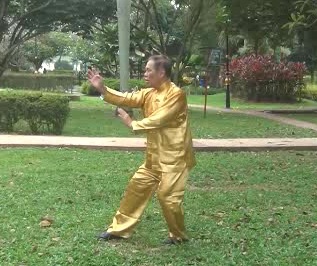HISTORY AND PHILOSOPHY OF
FIVE ELEMENTAL FIST OF XINGYIQUAN

Three-Body Poise of Five Elemental Fist
Xingyiquan, or Hsing Yi Kungfu, was invented by the Sage of Martial Arts, Marshal Yue Fei, in the 12th century during the Song Dynasty. Yue Fei also invented Eagle Claw Kungfu and Yue Jia Kungfu (pronounced as Ngok Ka Kungfu in Cantonese) which means Yue Family Kungfu. As a marshal, Yue Fei never lost a battle in more than 200 battles against the Tartars.
Yue Fei taught his generals Xingyiquan, and his ordinary soldiers Eagle Claw Kungfu. At first I was puzzled why Xingyiquan was the "Kungfu for Generals", whereas Eagle Claw Kungfu with a lot of sophisticated techniques for gripping was only "Kungfu for Ordinary Soldiers". I thought it was because of the tremendous internal force in Xingyiquan, as generals naturally had more internal force than ordinary soldiers.
I also thought, wrongly, that without internal force, Xingyiquan would be quite useless. Unlike Eagle Claw Kungfu which is elaborated and has counters against different attacks, Xingyiquan is so simple. It would be difficult, I wrongly thought, for a Xingyiquan practitioner to defend himself against a felling attack, or to release himself from a grip. But if he had tremendous internal force, he could do so because of his overwhelming force, not because of his techniques.
However, during my preparation to teach Xingyiquan at the UK Summer Camp 2013, I discovered my mistakes and realized why Xingyiquan was the kungfu for generals. The simplicity of Xingyiquan was not because it lacked depth but due to its great depth. Suppose practitioners progressed from 1 to 100. They used techniques at 10 not because they had not progressed beyond 10, but they had gone beyond 100. As an analogy, a master craftsman used a simple tool, not because he did not know how to use complicated tools but because having developed the skills in using complicated tools, he found using a simple tool best served his purpose.
I also discovered another important fact concerning the simplicity of Xingyiquan. Xingyiquan techniques looked simple, and were actually simple. But to use these simple techniques well, one needed great skills which could be developed after practicing complex techniques. When one had the skills, he could use a simple technique like "pi-quan", which was simply thrusting out a palm strike, to counter any attack! This would be mind-boggling to most people.
It was said that the 12 Animal Forms of Xingyiquan were added to supplement the deficiency of Five-Elemental Fist. This could be true if a Xingyiquan student was not advanced. In the hand of a master, like a general who naturally would have more and deeper martial skills than ordinary soldiers, he could use any one of the five elemental fists to counter any attack!
Besides the simplicity, and profundity, of Xingyiquan techniques, there is also the simplicity and profundity of skills. In exploding internal force, for example, practitioners of other kungfu styles would have to rotate their waist to explode force from their dan tian, unless they are high-level masters with internal force at their wrist. But Xingyiquan exponents could explode force from their elbows or shoulders without having to rotate their waist. This was possible by training the Three-Body Stance using the Expansion Mode and the Correspondence Mode which I learned from a Xingyiquan classic.
This also helped me to solve a problem which had been troubling me for some time. I wondered why the Three-Body Stance used to develop internal force was asymmetrical. The Expansion Mode and the Correspondence Mode provided me with the solution.
Wong Kiew Kit
18th December 2015
LINKS
Five Elemental Fist in Pictures
Combat Application of Five Elemental Fist -- Five-Flower Cannon
